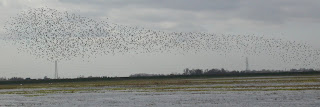 Part of the 5000 or so Icelandic black tailed godwits that provided the Nene Washes with a new spectacle, the previous winter record count was 1746 earlier on in February.
Part of the 5000 or so Icelandic black tailed godwits that provided the Nene Washes with a new spectacle, the previous winter record count was 1746 earlier on in February.
 Quite a few of the birds are colour ringed, indicatingthat most birds had recently been on the east coast at sites like breydon water, the wash and the humber estuary, but some had also come from Chichester harbour on the south coast and the Dee estuary.
Quite a few of the birds are colour ringed, indicatingthat most birds had recently been on the east coast at sites like breydon water, the wash and the humber estuary, but some had also come from Chichester harbour on the south coast and the Dee estuary.

 Wikipedia quote. The stoat's coat is a rich medium brown with an off-white belly. In winter, the coat is thicker and in regions that experience an inch or more of snow for at least forty days of the year (I used to be alot colder here in winter!) the color changes to clean white. This white fur is known as "ermine", a term originating either from the Latin phrase "Armenius mūs" ("Armenian rat") or from a word common to the Germanic and Baltic languages, hence the scientific name. At this stage the stoat itself may be referred to as ermine, or as being "in ermine".
Wikipedia quote. The stoat's coat is a rich medium brown with an off-white belly. In winter, the coat is thicker and in regions that experience an inch or more of snow for at least forty days of the year (I used to be alot colder here in winter!) the color changes to clean white. This white fur is known as "ermine", a term originating either from the Latin phrase "Armenius mūs" ("Armenian rat") or from a word common to the Germanic and Baltic languages, hence the scientific name. At this stage the stoat itself may be referred to as ermine, or as being "in ermine".
 spoony visited the washes last week, favouring a shallow ditch alongside 15 little egrets.
spoony visited the washes last week, favouring a shallow ditch alongside 15 little egrets. Skylark nest, just hatched out, the punkiest chicks i've ever seen.
Skylark nest, just hatched out, the punkiest chicks i've ever seen. Corncrake release's continue
Corncrake release's continue Returning males increased to 12-14 , which is a major leap in the project so far. Calling patterns also indicate that birds are doing what they should be with lots of second phase territories being set up. Its vital that females breed twice to produce enough young to set-up a sustainable population, this means delaying mowing in their chosen fields until mid-August.
Returning males increased to 12-14 , which is a major leap in the project so far. Calling patterns also indicate that birds are doing what they should be with lots of second phase territories being set up. Its vital that females breed twice to produce enough young to set-up a sustainable population, this means delaying mowing in their chosen fields until mid-August.












